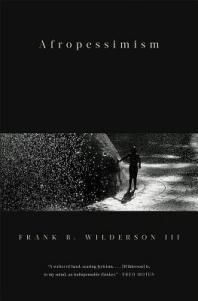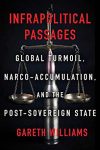 Frank Wilderson’s much-heralded new book, Afropessimism, is uneven, inconsistent, frequently repetitive and frustrating, even off-putting. At the end of it all, I’m not sure I liked it much. But it is also often compelling and definitely an important statement, a manifesto of sorts, that should be read by anyone involved in critical theory or political movements today. Indeed, its faults and rough edges are part of the point. This is not a book that seeks to win friends. Quite the opposite: Wilderson notes without apology that it is “common for most people to feel like they’d been mugged by Afropessimism” (328). This is a book that aims to take you by surprise and leave you reeling on the ground, even (especially) if you thought yourself an ally of progressive anti-racist politics.
Frank Wilderson’s much-heralded new book, Afropessimism, is uneven, inconsistent, frequently repetitive and frustrating, even off-putting. At the end of it all, I’m not sure I liked it much. But it is also often compelling and definitely an important statement, a manifesto of sorts, that should be read by anyone involved in critical theory or political movements today. Indeed, its faults and rough edges are part of the point. This is not a book that seeks to win friends. Quite the opposite: Wilderson notes without apology that it is “common for most people to feel like they’d been mugged by Afropessimism” (328). This is a book that aims to take you by surprise and leave you reeling on the ground, even (especially) if you thought yourself an ally of progressive anti-racist politics.
What is Afropessimism? It can perhaps most easily be contrasted (as it is throughout this book) with identity politics such as feminism. If feminism has been defined as “the radical notion that women are human beings,” Afropessimism is the perhaps still more radical notion that Blacks are not human. More precisely, Blacks are “the foil of Humanity” (13). It is their exclusion from the Human, effected through constant, gratuitous violence, that enables the constitution of Humanity as such that is thus parasitical on a Blackness that it both requires and refuses: “just as economic production is parasitic on the labor power of the working class, the production of Human capacity is parasitic on the flesh of the Slave, the Black” (192). Hence, where the aim of feminism (or, say, LGBTQ politics) is to reclaim a humanity denied to women (or lesbians, gays, etc.), Afropessimism by contrast refuses a humanity that it sees as inherently “unethical” (333) because of its dependency on anti-Black violence. Hence, indeed, Afropessimism is cast not simply in contrast to identity politics but also against them, as well as against any other notionally progressive movement (Marxism, postcolonialism, or whatever) for which the Human is taken for granted or even upheld as the terrain or object of its struggle. The “pessimism” of Afropessimism, then, surely arises in part because (it claims) Blacks will be perpetually disappointed if not betrayed by their would-be allies on the Left. And the mugging that it delivers hits hardest at those (Black or non-Black) invested in a solidarity politics that it claims is at best impossible, at worst damaging to any prospect of Black liberation.
What is Black liberation? Wilderson spends much more time describing what it is not than what it is. As he puts it, “Afropessimism has no prescriptive gesture.” In so far as it envisages a future, it is quite literally apocalyptic: “The end of our suffering signals the end of the Human, the end of [the] world” (331). This is, Wilderson admits, “a program of complete disorder” (250). But Blacks can welcome the end of the world because whereas (say) women or “non-Black people of color [. . .] have something to salvage,” Blacks by contrast “have nothing to lose” (176). Moreover, Wilderson adds that “The desire to be embraced, and elaborated, by disorder and incoherence is not anathema in and of itself. No one, for example, has ever been known to say, Gee whiz, if only my orgasms would end a little sooner, or maybe not come at all” (250). As such, liberation seems to involve an affirmation of the Real, not far distant (despite the reference here to the “faux-politics of Deleuze” [183]) from the untamed expression of desiring-production championed by schizoanalysis.
So Afropessimism is not entirely novel, however much it breaks (at time abruptly) from many of the assumed verities of identity politics or the mainstream left, even in its “intersectionalist” guise. It has much in common with at least one strain of Subaltern Studies (à la Spivak, for instance), as well as with the approach that some of us have been advancing in terms of “posthegemony” and “infrapolitics” and the like. Wilderson certainly has no truck with the Gramscian conceptions of hegemony and civil society, but he returns to them repeatedly as they encapsulate all that he finds wrong with so much of what passes for progressive thinking and leftist political strategy today: “coalitions and social movements [. . .] bound up in the solicitation of hegemony [. . .] ultimately accommodate only the satiable demands and legible conflicts of civil society’s junior partners [. . .] but foreclose upon the insatiable demands and illegible antagonisms of Blacks” (222-3). For Wilderson, political analysis and strategy alike must move beyond the confines of a hegemony theory that only makes things worse, blind as it is to the constituent violence that grounds hegemony itself, seared into Black flesh before the play of either consent or coercion can kick in. Where Afropessimism most strikingly breaks from Subaltern Studies or posthegemony, however, is precisely in that it is Black flesh that is at issue. Here, the excluded subaltern position is explicitly and specifically (and uniquely) coded as Black. Women, gays, the indigenous, the working class (and so on) are never, for Wilderson, subaltern in this sense, as they always have something at stake in the struggle for hegemony. For Blacks, by contrast, what is as stake is hegemony itself, which is only thinkable on the basis of their a priori exclusion from civil society tout court.
It is this assertion that is no doubt one of the most controversial among the many incendiary positions that Wilderson stakes out. Indeed, he chronicles at length the fall-out of one occasion in which he made this argument about Black singularity, at a conference in Berlin where all hell broke loose after he gave a paper on Afropessimism. We can agree that there is something at best distasteful about what he calls an “oppression Olympics” in which injustices would be compared and measured. To use Wilderson’s terms, there is no analogy between (say) the genocide that was the transatlantic slave trade and the genocide that was the European Holocaust. The two histories are incomparable. Indeed, Wilderson would argue that anti-black violence is not even historical; it is what grounds historical narrative without fully being registered by it. Yet, on the one hand, it is undeniable that the slave trade is also historical; its trace can be found even in the historical record that can never do it justice. And, on the other hand, there is something about the Holocaust (and not just the Holocaust) that also both subtends and escapes narrative rationality. In other words, we may accept Wilderson’s analytic distinction between a “contingent” violence that is subject to the logic of hegemony, and an “absolute” or “gratuitous” violence inflicted upon those constitutively excluded from that logic, without necessarily agreeing that only Blacks suffer gratuitous violence, or that the violence inflicted on other social groups is always and inevitably contingent.
Take for instance the post-conquest treatment of the indigenous peoples of the Americas, or more generally colonial violence. Addressing the “Native American genocide,” Wilderson acknowledges that “there are pre-logical or libidinal elements to the murder of eighteen million people–to be sure. But,” he continues, “land acquisition and usurpation give the genocide a kind of coherence and reasonableness” (219; emphasis added). Here that qualification that this is only “a kind of” reasonableness is doing a lot of work, and elsewhere even such qualification is absent as when (only a few pages later) Wilderson posits that “I know that I am not Black because when and if I experience the kind of violence Blacks experience there is a reason, some contingent transgression” (225; emphasis in the original). This is all too close to saying that such violence is indeed reasonable (or at least, that it has its reasons), when surely in fact there is always something in colonial violence–and likewise in the violence of anti-Semitism, misogyny, homophobia, and so on–that exceeds or undermines any possible reason. Conversely, it is surely also true that reasons have been adduced to justify slavery, however rephrehensible those reasons may be, mere figleaves for motivations grounded in what Wilderson denotes as “libidinal economy,” but without them there would never have been debates between slavers and abolitionists; without them, the tireless campaigning of someone like Fredrick Douglass would have been literally senseless.
In Wilderson’s book, the argument that Blacks are not (simply) the foil of Humanity is put most eloquently by the author’s mother, and her critique goes unanswered when she tells her son that “she wasn’t anybody’s slave, and that even when our ancestors were slaves they were Human beings” (329). Wilderson’s response is an uneasy joke (with reference to his white wife, “’Being Human isn’t anything to aspire to,’ I said. ‘Just ask Alice’” [329]). A better rejoinder might have been the observation that they weren’t simply Human beings, and that Afropessimism is interested in operationalizing the gap between Human and Black. But one would have to add that, as the old feminist slogan indicates, such a gap between Human and non-Human traverses many social groups, and perhaps ultimately all of us in one way or another. And to say this is not to assert any false equivalence, any reactionary equalization along the lines of “All Lives Matter.” On the contrary: the gap between any violence to which I may potentially be subject and the violence of slavery (whether historical or ongoing) is incommensurable. But as is attested by Wilderson’s own frequent recourse in this book to autobiographical stories (of his childhood in Minnesota, of a breakdown in Berkeley, or of his experiences in South Africa, for instance), the trace of that incommensurability is to be found in narrative, in history, even if it also always subverts and escapes them.
In short, Wilderson concedes all too much to hegemony, as though it fully (and implicitly without remainder) explained all other forms of oppression and violence that are not anti-Black violence. And at the same time, he could do more to think through the relationship, however contingent, between the anti- or non- (post?) hegemonic position that he ascribes to Blackness and the discursive procedures, his own included, by which that position is both acknowledged and inevitably disavowed. This may win no more friends, but it might suggest a theory of friendship (fleeting or otherwise) that could suggest paths to common programs without the mystifications of solidarity.





 Frank Wilderson’s much-heralded new book,
Frank Wilderson’s much-heralded new book,